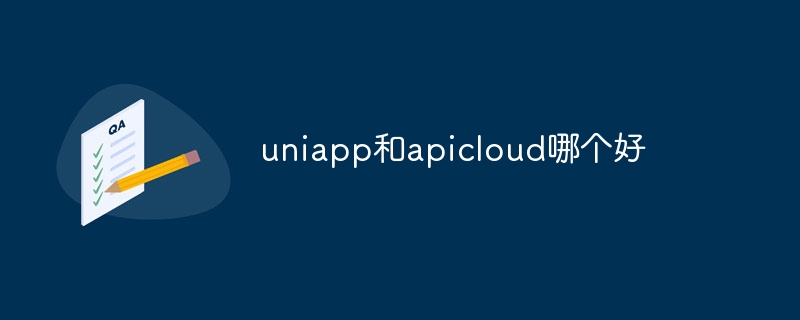Which one is better, uniapp or apicloud?
Overall, both uniapp and apicloud are excellent cross-platform development frameworks, and the choice depends on the specific needs of the project. UniApp is easy to use and has strong cross-platform capabilities, making it suitable for individual developers and small application development; APICloud focuses on enterprise-level applications, provides powerful back-end services and security, and is suitable for larger-scale enterprise-level applications.

Comparative analysis of uniapp and apicloud
Which one is better?
Overall, uniapp and apicloud are both excellent cross-platform development frameworks, but each has its own focus. Which one you choose depends on the specific requirements of your particular project.
Function comparison
uniapp:
- Rich component library and API
- Support Vue.js ecosystem is more convenient to use
- Good cross-platform capabilities, supports multiple platforms such as iOS, Android, H5, etc.
- Has complete debugging and simulation tools
apicloud:
- Focus on enterprise-level application development
- Has powerful back-end services, providing cloud database, file storage, message push, etc. Function
- Excellent security, supports identity authentication, data encryption, etc.
- Provides a wealth of templates and plug-ins to simplify the development process
Advantages and disadvantages Comparison
uniapp:
- Advantages: easy to use, active community, strong cross-platform capabilities
- Disadvantages: May not be suitable Larger-scale enterprise-level applications
apicloud:
- Advantages: Powerful back-end services, high security, suitable for enterprise-level applications
- Disadvantages: Steep learning curve, small community size, slightly weaker cross-platform capabilities
Selection suggestions
- For individuals For developers or developers who need to quickly develop small applications, uniapp is a good choice.
- For developers who need to develop enterprise-level applications, powerful back-end services and high security, apicloud is more suitable.
- If cross-platform capabilities are the primary consideration, uniapp can provide better support.
- If backend services and security are key requirements, APICloud is a better choice.
The above is the detailed content of Which one is better, uniapp or apicloud?. For more information, please follow other related articles on the PHP Chinese website!

Hot AI Tools

Undresser.AI Undress
AI-powered app for creating realistic nude photos

AI Clothes Remover
Online AI tool for removing clothes from photos.

Undress AI Tool
Undress images for free

Clothoff.io
AI clothes remover

Video Face Swap
Swap faces in any video effortlessly with our completely free AI face swap tool!

Hot Article

Hot Tools

Notepad++7.3.1
Easy-to-use and free code editor

SublimeText3 Chinese version
Chinese version, very easy to use

Zend Studio 13.0.1
Powerful PHP integrated development environment

Dreamweaver CS6
Visual web development tools

SublimeText3 Mac version
God-level code editing software (SublimeText3)

Hot Topics
 1387
1387
 52
52
 How to use bootstrap in vue
Apr 07, 2025 pm 11:33 PM
How to use bootstrap in vue
Apr 07, 2025 pm 11:33 PM
Using Bootstrap in Vue.js is divided into five steps: Install Bootstrap. Import Bootstrap in main.js. Use the Bootstrap component directly in the template. Optional: Custom style. Optional: Use plug-ins.
 How to add functions to buttons for vue
Apr 08, 2025 am 08:51 AM
How to add functions to buttons for vue
Apr 08, 2025 am 08:51 AM
You can add a function to the Vue button by binding the button in the HTML template to a method. Define the method and write function logic in the Vue instance.
 How to reference js file with vue.js
Apr 07, 2025 pm 11:27 PM
How to reference js file with vue.js
Apr 07, 2025 pm 11:27 PM
There are three ways to refer to JS files in Vue.js: directly specify the path using the <script> tag;; dynamic import using the mounted() lifecycle hook; and importing through the Vuex state management library.
 How to use watch in vue
Apr 07, 2025 pm 11:36 PM
How to use watch in vue
Apr 07, 2025 pm 11:36 PM
The watch option in Vue.js allows developers to listen for changes in specific data. When the data changes, watch triggers a callback function to perform update views or other tasks. Its configuration options include immediate, which specifies whether to execute a callback immediately, and deep, which specifies whether to recursively listen to changes to objects or arrays.
 What does vue multi-page development mean?
Apr 07, 2025 pm 11:57 PM
What does vue multi-page development mean?
Apr 07, 2025 pm 11:57 PM
Vue multi-page development is a way to build applications using the Vue.js framework, where the application is divided into separate pages: Code Maintenance: Splitting the application into multiple pages can make the code easier to manage and maintain. Modularity: Each page can be used as a separate module for easy reuse and replacement. Simple routing: Navigation between pages can be managed through simple routing configuration. SEO Optimization: Each page has its own URL, which helps SEO.
 How to return to previous page by vue
Apr 07, 2025 pm 11:30 PM
How to return to previous page by vue
Apr 07, 2025 pm 11:30 PM
Vue.js has four methods to return to the previous page: $router.go(-1)$router.back() uses <router-link to="/" component window.history.back(), and the method selection depends on the scene.
 How to query the version of vue
Apr 07, 2025 pm 11:24 PM
How to query the version of vue
Apr 07, 2025 pm 11:24 PM
You can query the Vue version by using Vue Devtools to view the Vue tab in the browser's console. Use npm to run the "npm list -g vue" command. Find the Vue item in the "dependencies" object of the package.json file. For Vue CLI projects, run the "vue --version" command. Check the version information in the <script> tag in the HTML file that refers to the Vue file.
 How to use vue traversal
Apr 07, 2025 pm 11:48 PM
How to use vue traversal
Apr 07, 2025 pm 11:48 PM
There are three common methods for Vue.js to traverse arrays and objects: the v-for directive is used to traverse each element and render templates; the v-bind directive can be used with v-for to dynamically set attribute values for each element; and the .map method can convert array elements into new arrays.




